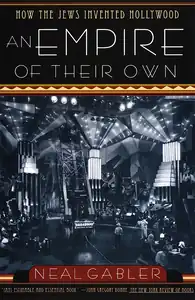An Empire of Their Own
An Empire of Their Own: How the Jews Invented Hollywood is a 1988 non-fiction book whose topic is the careers of several prominent Jewish film producers in the early years of Hollywood.[1] Author Neal Gabler focuses on the psychological motivations of these film moguls, arguing that their background as Jewish immigrants shaped their careers and influenced the movies they made.
 | |
| Author | Neal Gabler |
|---|---|
| Country | United States |
| Language | English |
| Genre | Non-fiction |
| Publisher | Crown |
Publication date | 1988 |
| Media type | Print (Hardback and paperback) |
| Pages | 502 pp (hardback) |
| ISBN | 0-385-26557-3 |
Themes
Gabler's main thesis is that these producers (whom Gabler terms "Hollywood Jews") generally came from poor, fatherless backgrounds, and felt like outsiders in America because of their Jewishness. In Hollywood, these producers were able to run their own industry, assimilate into the American mainstream, and produce movies that fulfilled their vision of the American Dream. In an interview with LA Times, Gabler speaks about the title of the book and American Dream:
They had a hunger for assimilation and, in the face of resistance and exclusion, "the Jews could simply create new a country--an empire of their own, so to speak . . . an America where fathers were strong, families stable, people attractive, resilient, resourceful, and decent." The 20th-Century American Dream was to a considerable degree depicted and defined by Hollywood.[2]
Gabler asserts that the nature of their business and their movies can often be traced back to their feelings of alienation as immigrants.
The book also explains that the business background of the Hollywood Jews in theatre-ownership, retail distribution, and the garment industry shaped the approach these studio owners took to crafting movies for a popular audience, one similar to the marketing of films as commodities as well as works of art.
The title of the book is a reference to F. Scott Fitzgerald's unfinished novel The Last Tycoon, in which Fitzgerald describes his protagonist, Monroe Stahr (a character inspired by the producer Irving Thalberg) as "coming home to an empire of his own—an empire he has made."[3][4][5] The book won the 1989 Los Angeles Times Book Prize for history[6] and the 1989 Theatre Library Association Award.[7]
Adaptations
The book was adapted into a documentary film in 1998, a decade after the book was published. The movie has two titles: Hollywoodism: Jews, Movies and the American Dream (original title for A&E) and Hollywood: An Empire of Their Own (title for video/DVD). The documentary won an award for Best Jewish Experience Documentary at the 1998 Jerusalem Film Festival.[8]
See also
Notes
- Miller, Randall M. (1984). Friedman, Lester D.; Goldman, Eric A.; Cohen, Sarah Blacher (eds.). "Jews in (and on, behind, and around) Film". American Jewish History. 74 (2): 189–193. ISSN 0164-0178. JSTOR 23890467.
- Champlin, Charles (1988-09-25). "The Founding Fathers of Hollywood : AN EMPIRE OF THEIR OWN : How the Jews Invented Hollywood by Neal Gabler (Crown: $24.95; 491 pp.)". Los Angeles Times. Retrieved 2021-01-29.
- Charles Champlin, "The Founding Fathers of Hollywood", Los Angeles Times September 25, 1988.
- Sander L. Gilman (1997). Smart Jews: The Construction of the Image of Jewish Superior Intelligence. U of Nebraska Press. p. 175. ISBN 0-8032-7069-0.
- F. Scott Fitzgerald; Matthew J. Bruccoli (1993). The Love of the Last Tycoon: A Western. Cambridge University Press. p. 199. ISBN 978-0-521-40231-6.
- 1989 Los Angeles Times Book Prize Winners Archived 2011-02-22 at the Wayback Machine (accessed March 31, 2011).
- Theatre Library Association Award - Winners, 1974-2009 Archived 2011-11-05 at the Wayback Machine (accessed March 31, 2011).
- Review summary for Hollywood: An Empire of Their Own (1998), Baseline entry reprinted in The New York Times (accessed March 31, 2011).
References
- Gabler, Neal (1988). An Empire of Their Own: How the Jews Invented Hollywood. Crown. ISBN 0-385-26557-3.
- Langdon, Jennifer (2009). Caught in the Crossfire: Adrian Scott and the Politics of Americanism in 1940s Hollywood. Columbia University Press. ISBN 978-0-231-14250-2.
External links
- An Empire of Their Own at IMDb
- Gabler, Neal. An Empire of Their Own at Google Books (preview)